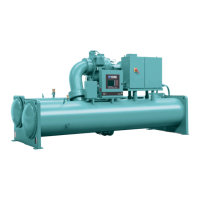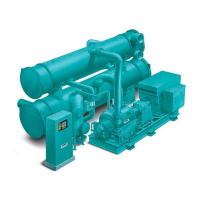Hot insulation and cold insulation procedure
1. The suggested materials and their thickness for hot insulation or cold insulation are shown in
Table 5.
2. Use a bonding agent, iron wire, iron band, and so on, to fix the hot insulation/cold insulation
materials. Never rivet them. Do not use welding pins.
3. Make the outer cover, flanged parts, and evaporator water chamber casing easily removable to
facilitate servicing.
4. The points that require hot insulation or cold insulation are shown in Table 6.
5. The casing of the absorber and the condenser water chamber does not require hot insulation
or cold insulation. If insulation is used, make it easy to remove.
6. Install the generator insulation so that the front, sides, and rear sections can be removed
separately. All parts of the insulation on each side is removable.
Table 5: Insulating material and thickness
Hot insulation Cold insulation
Material Rock wool or glass wool Polyurethane foam, polystyrene foam, or glass wool
Thickness 2 in. (50 mm) 2 in. (50 mm)
Table 6: Points requiring hot or cold insulation
Point requiring hot insulation Point requiring cold insulation Point that must not be heat-insulated
Generator shell Evaporator shell Sight glass
Drain cooler / drain piping Evaporator water chamber case Valve manipulator
Solution return piping Refrigerant piping Pressure gauge
Refrigerant blow piping Thermometer insertion hole
Heat exchanger
Valve for vacuuming
(use a factory only)
Relay insertion hole
YHAU-C Single Effect Steam-Fired Absorption Chiller36

